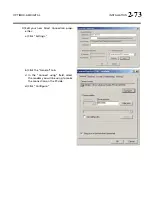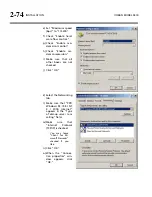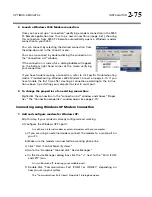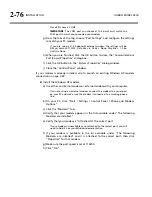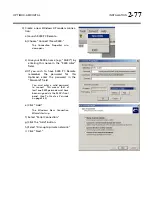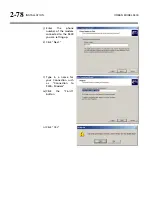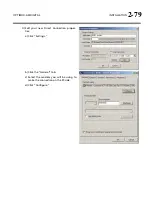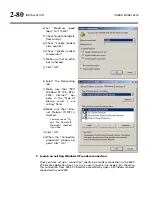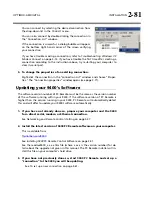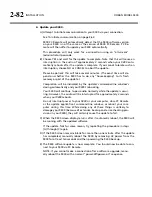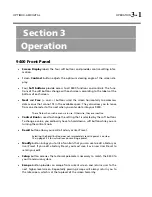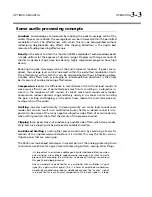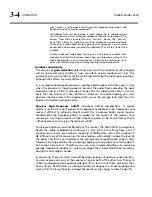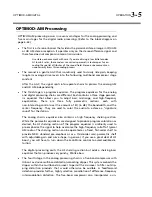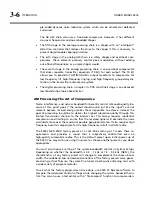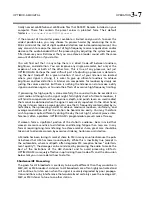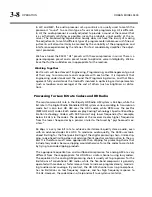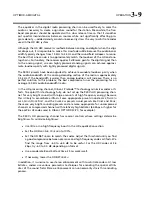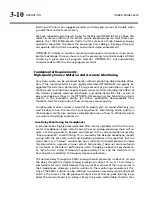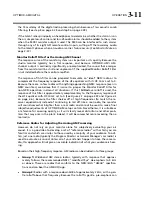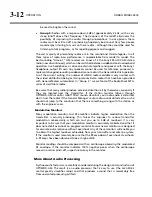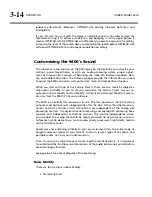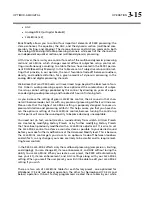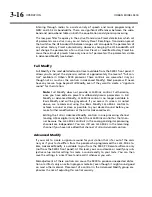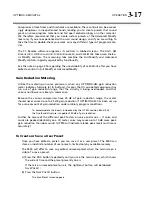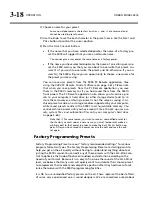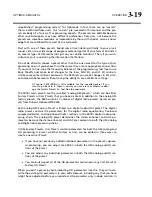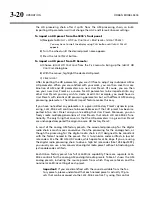
OPTIMOD-AM DIGITAL
OPERATION
3-5
OPTIMOD-AM Processing
OPTIMOD-AM processing occurs in seven main stages for the analog processing and
five main stages for the digital radio processing. (Refer to the block diagram on
page 6-62.)
The first is a stereo enhancer that widens the perceived stereo image in CQUAM
or HD AM stereo reception. It operates only on the stereo difference signal and
therefore does not compromise mono transmission.
Use stereo enhancement with care if you are driving a low bitrate codec.
At low bit rates, these codecs use various parametric techniques for en-
coding the spatial attributes of the sound field. Stereo enhancement can
unnecessarily stress this encoding process
The second is a gentle AGC that is ordinarily used to slowly ride gain, keeping
long-term average drive levels into the following multiband compressor stage
constant.
After the AGC, the signal splits into separate chains to process the analog AM
and HD AM independently.
The third stage is a program equalizer. The program equalizers for the analog
and digital processing chains are different. Each contains a three stage paramet-
ric equalizer that allows you to adjust bass, midrange, and high-frequency
equalization. There are three fully parametric sections, each with
non-interacting control over the amount of EQ (in dB), the bandwidth, and the
center frequency. They are used to color the audio to achieve a “signature
sound” for the station.
The analog chain’s equalizer also contains a high frequency shelving section.
While the parametric equalizers are designed to produce program coloration as
desired, the HF shelving section of the program equalizer is ordinarily used to
pre-emphasize the signal to help overcome the high-frequency rolloff of typical
AM radios. The shelving section can be operated as a fixed, first-order shelf to
provide NRSC standard pre-emphasis or as a third-order semi-parametric shelf
with adjustable gain and curve shape. In general, if you use a great deal of HF
boost, you will have to turn down the
L
ESS
-M
ORE
control to avoid audible dis-
tortion.
The digital processing omits the HF shelving section but adds a shelving bass
equalizer that can produce very punchy, FM-like bass.
The fourth stage in the analog processing chain is a five-band compressor with
Orban's exclusive multiband distortion-canceling clipper. This system embeds the
clipper within the multiband crossover to permit the crossover to filter out clip-
ping distortion products that would otherwise be audible. A feedforward
sidechain provides further, highly selective cancellation of difference-frequency
intermodulation distortion. The five-band compressor also incorporates a sin-
Summary of Contents for Optimod-AM 9400
Page 1: ...Operating Manual OPTIMOD AM 9400 Digital Audio Processor Version 1 2 Software...
Page 7: ...Operating Manual OPTIMOD AM 9400 Digital Audio Processor Version 1 2 Software...
Page 52: ......
Page 204: ......
Page 232: ......
Page 260: ......
Page 261: ...OPTIMOD AM DIGITAL TECHNICAL DATA 6 29...
Page 267: ...OPTIMOD AM DIGITAL TECHNICAL DATA 6 35 CPU Module...
Page 273: ...OPTIMOD AM DIGITAL TECHNICAL DATA 6 41 RS232 BOARD PARTS LOCATOR...
Page 275: ...OPTIMOD AM DIGITAL TECHNICAL DATA 6 43 8300 POWER SUPPLY PARTS LOCATOR...
Page 284: ...6 52 TECHNICAL DATA ORBAN MODEL 9400 DSP BOARD PARTS LOCATOR DRAWING 32170 000 14...
Page 292: ...6 60 TECHNICAL DATA ORBAN MODEL 9400 DISPLAY BOARD PARTS LOCATOR...
Page 293: ...OPTIMOD AM DIGITAL TECHNICAL DATA 6 61 DISPLAY BOARD...

